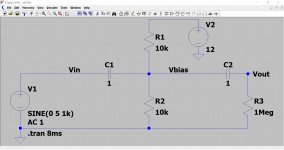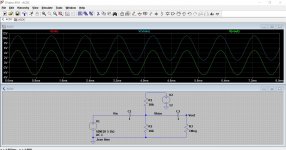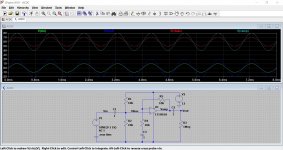Hi I am playing around with some components and is now stumbled upon if audio is AC or DC from a components point of view?
Shall I buy AC compatible or DC compatible when the audio signal has to go trough the component?
Shall I buy AC compatible or DC compatible when the audio signal has to go trough the component?
Do you mean the external power source for the component?
If the power jack is labeled AC/DC, that means you can
use an external power source of either type, because there
is a built-in rectifier and filter capacitor in the component.
If the power jack is labeled AC/DC, that means you can
use an external power source of either type, because there
is a built-in rectifier and filter capacitor in the component.
Oh sorry for being so unclear. I meant the power that is amplified, the audio-signal.
The audio is always considered as AC, since it is constantly reversing its polarity. An example:
Audio waveform animation, simple black and white sound wave as motion background Motion Background - Storyblocks Video
Last edited:
Thanks, I has just read to much on several forums and ended up confused since some say that it was AC with DC bias, DC since it did not cross the zero, neither since it was a waveform and so on🙂
I for one could use an example of a component you mean, because I don't understand what you are asking about.
Thanks, I has just read to much on several forums and ended up confused since some say that it was AC with DC bias, DC since it did not cross the zero, neither since it was a waveform and so on🙂
In most audio components it is true that the signal actually present inside has DC voltage as well as the AC from the audio. This is necessary for the component to work properly. The DC part is removed before it gets to the speaker, since speakers cannot deal with DC and will be damaged by any significant amount (more than a few volts).
If they were claiming that the DC bias of the circuit inside the component made the audio into DC
(that is, a single polarity wrt ground), this is technically correct. Any circuit using transistors or tubes
requires this kind of DC bias to function properly. But the DC is only present inside the component,
and is removed before the output of the component.
Last edited:
It sounds to me like you need to read a book rather than forums, preferably a textbook about audio amplifiers that is suitable for beginners.
Hi I am playing around with some components and is now stumbled upon if audio is AC or DC from a components point of view?
Shall I buy AC compatible or DC compatible when the audio signal has to go trough the component?
If you were to understand how a audio signal is amplified through, say, a power Transistor it would clarify for you.
Thanks all of you🙂
LOL yes it may be a funny question but noob is noob and I don't mind if people gets a good laugh.
But you will be amazed on how many who do not know it and who is arguing for one or the other. Just try to search "is audio signal ac or dc"🙂
LOL yes it may be a funny question but noob is noob and I don't mind if people gets a good laugh.
But you will be amazed on how many who do not know it and who is arguing for one or the other. Just try to search "is audio signal ac or dc"🙂
Try and think through what happens... from the voltage a microphone produces through to the voltage that appears across the speaker.
The microphone produces an AC voltage in response to air pressure changes. If we arbitrarily pick one terminal as a reference then the other terminal moves up and down in response. That's AC.
If we apply that voltage to an amplifier that runs on a 9 volt battery then we have to effectively superimpose that AC voltage onto the amplifier circuitry which is running on DC and we we do with an input coupling capacitor.
So we have AC at the mic side and some DC voltage determined by the circuit at the other side.
The AC audio signal now alters or modulates that DC and the amplifier does its thing and amplifies giving us a larger version of that input signal.
Within the amplifier running on its 9 volt supply we see that audio voltage moving between 0 volts and 9 volts.
So a question 🙂 Is that varying voltage now AC or is it just DC that is modulated. There is no right answer to that. What we can (and do) do next is put a cap at the amplifier output to remove the DC. That leaves us with an amplified version of the mic voltage and thanks to the cap we can now call that voltage AC again as it has no DC component.
The microphone produces an AC voltage in response to air pressure changes. If we arbitrarily pick one terminal as a reference then the other terminal moves up and down in response. That's AC.
If we apply that voltage to an amplifier that runs on a 9 volt battery then we have to effectively superimpose that AC voltage onto the amplifier circuitry which is running on DC and we we do with an input coupling capacitor.
So we have AC at the mic side and some DC voltage determined by the circuit at the other side.
The AC audio signal now alters or modulates that DC and the amplifier does its thing and amplifies giving us a larger version of that input signal.
Within the amplifier running on its 9 volt supply we see that audio voltage moving between 0 volts and 9 volts.
So a question 🙂 Is that varying voltage now AC or is it just DC that is modulated. There is no right answer to that. What we can (and do) do next is put a cap at the amplifier output to remove the DC. That leaves us with an amplified version of the mic voltage and thanks to the cap we can now call that voltage AC again as it has no DC component.
Shall I buy AC compatible or DC compatible when the audio signal has to go trough the component?
Components are not intrinsically ac or dc. Each component type has a behaviour that defines how that component behaves, understanding that means you understand how it responds to ac or dc or a combination of both.
Great explanation, so lets say I have 10VAC P/P that crosses Ground / Zero and then give it a bias of +6VDC, Now dos it not cross zero but goes from +1V to +11V, could you now call the AC+DC, DC with 10V ripple?Try and think through what happens... from the voltage a microphone produces through to the voltage that appears across the speaker.
The microphone produces an AC voltage in response to air pressure changes. If we arbitrarily pick one terminal as a reference then the other terminal moves up and down in response. That's AC.
If we apply that voltage to an amplifier that runs on a 9 volt battery then we have to effectively superimpose that AC voltage onto the amplifier circuitry which is running on DC and we we do with an input coupling capacitor.
So we have AC at the mic side and some DC voltage determined by the circuit at the other side.
The AC audio signal now alters or modulates that DC and the amplifier does its thing and amplifies giving us a larger version of that input signal.
Within the amplifier running on its 9 volt supply we see that audio voltage moving between 0 volts and 9 volts.
So a question 🙂 Is that varying voltage now AC or is it just DC that is modulated. There is no right answer to that. What we can (and do) do next is put a cap at the amplifier output to remove the DC. That leaves us with an amplified version of the mic voltage and thanks to the cap we can now call that voltage AC again as it has no DC component.
That choice is language, which does not perfectly describe the situation. The signal has both AC & DC components. That situation is one reason we picture scope traces and post them on the site.
Ripple is a particular AC signal, one that exists at the power line frequency, only. When connected to a speaker ripple causes "hum".
We use capacitors or transformers before the speaker sometimes to remove the DC from the AC music. Other times we use complicated circuits to turn on one transistor to do the plus part of the AC signal (npn), then turn it off and use another transistor to do the negative parts of the signal (pnp). This is called push pull or Class AB or Class B transistor use.
Ripple is a particular AC signal, one that exists at the power line frequency, only. When connected to a speaker ripple causes "hum".
We use capacitors or transformers before the speaker sometimes to remove the DC from the AC music. Other times we use complicated circuits to turn on one transistor to do the plus part of the AC signal (npn), then turn it off and use another transistor to do the negative parts of the signal (pnp). This is called push pull or Class AB or Class B transistor use.
Great explanation, so lets say I have 10VAC P/P that crosses Ground / Zero and then give it a bias of +6VDC, Now dos it not cross zero but goes from +1V to +11V, could you now call the AC+DC, DC with 10V ripple?
That's it

This shows exactly what you describe. Vin and Vout are actually superimposed on each other on the trace here because they are the same.
Attachments
I am glad you are explaining it, so what are the definition on DC?
1) Not a constant non changing value because DC can have ripple?
2) Can DC not also go below zero / cross zero?
1) Not a constant non changing value because DC can have ripple?
2) Can DC not also go below zero / cross zero?
Last edited:
I am glad you are explaining it, so what are the definition on DC? (Not a constant non changing value because DC can have ripple?)
I'll let someone else answer that because I've grown up knowing what DC means... which is essentially a static voltage and so I sort of look beyond that when visualising circuit theory.
Here is the same little circuit but now with an amplifier in the middle. The amp is configured for a gain of 2 and we are applying 1 volt peak or 2 volts peak to peak.
Now you can see all the voltages and how they vary. So is the output of the amplifier itself (the opamp) AC or DC or modulated DC 😉 Someone else can give an opinion on that one.
Attachments
I am glad you are explaining it, so what are the definition on DC?
1) Not a constant non changing value because DC can have ripple?
2) Can DC not also go below zero / cross zero?
DC can have an AC component present such as ripple, however if you look at this in the time domain (such as on a scope trace) then it is just one varying voltage.
There are not two voltages existing at the same time. It is always one voltage that differs with respect to time. Now when we talk of ripple its common to say there is say a 1 volt ripple component on say a 10 volt DC rail.
DC can be any value you like with respect to any other point (such as ground). If it takes an hour to fall from +10v to 0 and then another hour to reach -10 volts would we describe that as AC or slowly changing DC as some might?
I would call it AC but understand what anyone calling it the latter meant.
I think one way to look at it might be to say its DC if it doesn't change over the time period of interest. So does your torch bulb see 3 volts DC or an AC voltage of 3 volts peak which would include the on and off switching.
- Status
- Not open for further replies.
- Home
- Amplifiers
- Solid State
- Audio AC components or DC?


